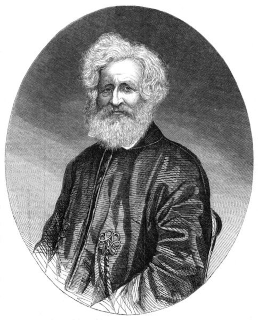
Sir William Francis Patrick Napier, a soldier in the British Army and a military historian, is born on December 17, 1785, at Castletown, near Celbridge, County Kildare.
Napier is the third son of Colonel George Napier and his second wife, Lady Sarah Lennox, seventh daughter of Charles Lennox, 2nd Duke of Richmond, and previously wife of Sir Charles Thomas Bunbury, MP. His elder brothers are General Sir Charles James Napier (1782–1853), the conqueror of Sindh, and General Sir George Thomas Napier (1784–1855), governor of the Cape Colony. He is a first cousin of Charles James Fox and also of Lord Edward FitzGerald.
Educated locally, he enters the British Army as an ensign in the Royal Irish Regiment of Artillery on June 14, 1800. Transferring to the 62nd (Wiltshire) Regiment of Foot, he is promoted to lieutenant on April 18, 1801, but is placed on half pay at the Treaty of Amiens in March 1802. He is promoted to captain in June 1804, transferring to the 43rd (Monmouthshire) Regiment of Foot in August, and in 1806 is sent to Ireland on a recruiting tour, with instructions to recruit men from the militia to serve in the line regiments. In July 1807 he serves with his regiment under the command of General Arthur Wellesley during the successful Second Battle of Copenhagen and is present at the Battle of Køge.
In September 1808 Napier sails with his regiment to Spain, where he serves throughout the Peninsular campaign of Gen. Sir John Moore. He is present at many of the major actions of the later campaigns, including the Combat of the Côa in July 1810, where he is wounded, the Battle of Bussaco on September 27, 1810, and the actions at Pombal and Redinha. At the action at Casal Novo on March 14, 1811, he is severely wounded while leading forward six companies of the 52nd (Oxfordshire) Regiment of Foot in an effort to harass the rearguard of André Masséna‘s army. He later returns to the army, with his wound still open and a bullet lodged near his spine, and is appointed as brigade major to the Portuguese brigade. He takes part in the Battle of Fuentes de Oñoro on May 3-5, 1811, and is promoted to major at the end of the month.
Succumbing to fever, Napier returns to England. During a period of leave, he marries his cousin, Caroline Amelia Fox, daughter of General Henry Edward Fox and niece of Charles James Fox in February 1812. After his leave he returns to Portugal and takes command of the 43rd (Monmouthshire) Regiment of Foot as senior major present. He subsequently serves in the battles of Salamanca on July 22, 1812, Nivelle on November 10, 1813, and Nive on December 10-13, 1813, which is Marshal Jean-de-Diew Soult‘s last attempt to drive the allied army from France. Promoted to lieutenant-colonel in November 1813, he is present at the Battle of Orthez on February 27, 1814, but has to return to England due to wounds and illness. He is subsequently awarded the gold and silver Peninsular medal, with two and three clasps respectively. Arriving too late in France in 1815, he takes no part in the ‘Hundred days’ campaign and retires from the active list in 1819. He is made a Knight Commander of the Order of the Bath (KCB) in the same year.
Napier devotes the rest of his life to historical writing, initially contributing an article to the Edinburgh Review in 1821. In 1823, at the suggestion of Henry Bickersteth, 1st Baron Langdale, he begins writing his History of the War in the Peninsula and the South of France, 1807–1814 (6 vols., 1828–40). This epic work, which runs to several editions, makes use of material supplied by both the Duke of Wellington and the French marshals Soult and Suchet, while papers of Joseph Bonaparte, captured after the Battle of Vittoria, are also made available to him. In July 1830 he is promoted to full colonel. Promoted to major-general in November 1841, he is appointed Lieutenant Governor of Guernsey (1842–47). Appointed colonel of the 27th (Inniskilling) Regiment of Foot in February 1848, he is made a KCB in May 1848.
Napier later publishes several works centred on his brother, Gen. Sir Charles James Napier, after the latter resigns as commander-in-chief in India. These include History of Sir Charles James Napier’s Administration of Scinde (1851) and Life and Opinions of General Sir Charles James Napier (4 vols., 1857). As both of these works seek to vindicate his brother, they are generally seen to be biased in the extreme. Subsequently promoted to lieutenant-general on November 11, 1851, and general on October 17, 1859, he spends his later years troubled by ill health. He dies on February 12, 1860, at his London residence, Scinde House in Clapham, and is buried at West Norwood Cemetery.
There is a fine marble statue of Napier in St. Paul’s Cathedral, London. His letters are in the Bodleian Library, University of Oxford.
(From: “Napier, Sir William Francis Patrick” by David Murphy, Dictionary of Irish Biography, http://www.dib.ie, October 2009)

